Blue Hydrogen Market Size and Forecast 2025 to 2034
The global blue hydrogen market size was estimated at USD 4.64 billion in 2024 and is predicted to increase from USD 5.53 billion in 2025 to approximately USD 25.45 billion by 2034, expanding at a CAGR of 25.45% from 2025 to 2034. This market is driven by several countries setting targets for reducing carbon and greenhouse gas (GHG) emissions by adopting hydrogen as an alternative in the energy transition.
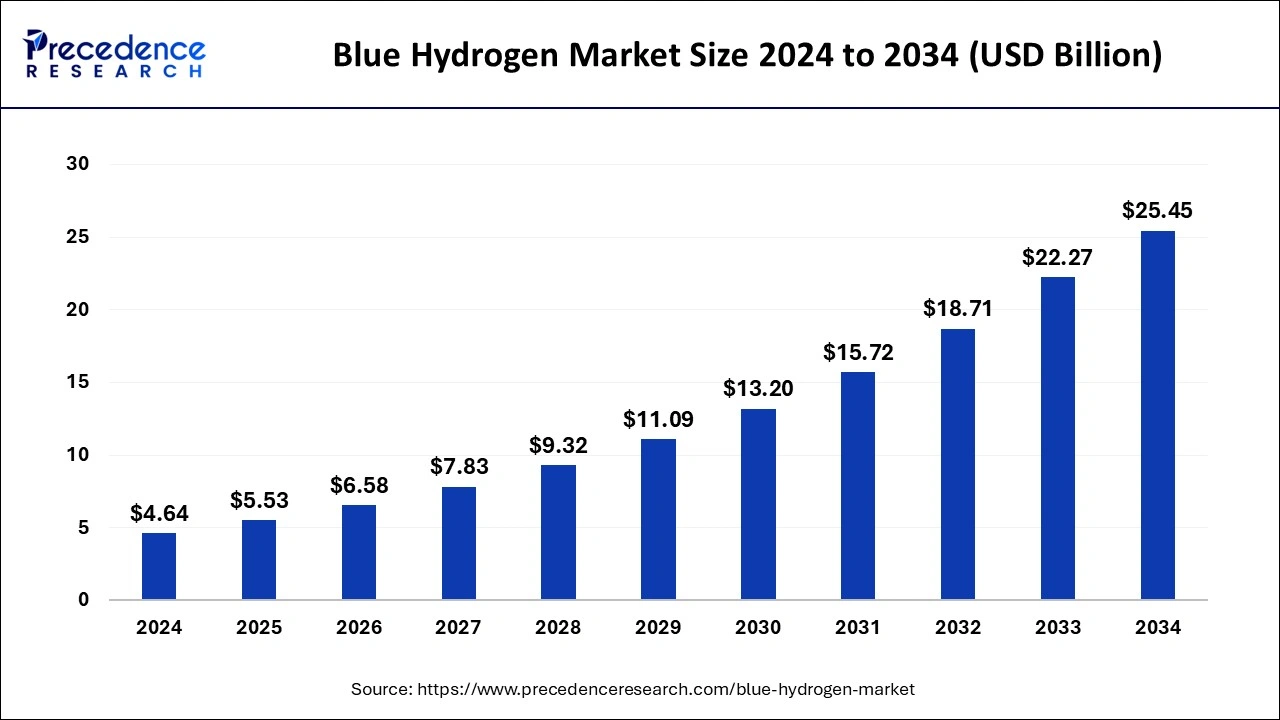
Blue Hydrogen Market Key Takeaways
- In terms of revenue, the global blue hydrogen market was valued at USD 4.64 billion in 2024.
- It is projected to reach USD 25.45 billion by 2034.
- The market is expected to grow at a CAGR of 25.45% from 2025 to 2034
- Middle East & Africa dominated the market with the largest revenue share of 35% in 2024.
- Europe is projected to grow at the fastest CAGR of 22.65% during the forecast period.
- By technology, the steam methane reforming segment has contributed more than 63% of revenue share in 2024.
- By technology, the auto thermal reforming segment is expected to grow at a significant rate in the market over the forecast period.
- By transportation mode, the pipeline segment has held the largest revenue share of 73% in 2024.
- By transportation mode, the cryogenic liquid tankers segment is expected to grow at the fastest rate during the forecast period.
- By application, the power generation segment has recorded more than 39% of revenue share in 2024.
- By application, the refinery segment is anticipated to grow at a solid CAGR of 20.62% over the projected period.
Middle East & Africa Blue Hydrogen Market Size and Growth 2025 to 2034
The Middle East & Africa blue hydrogen market size was exhibited at USD 1.62 billion in 2024 and is projected to be worth around USD 9.03 billion by 2034, growing at a CAGR of 18.75% from 2025 to 2034.
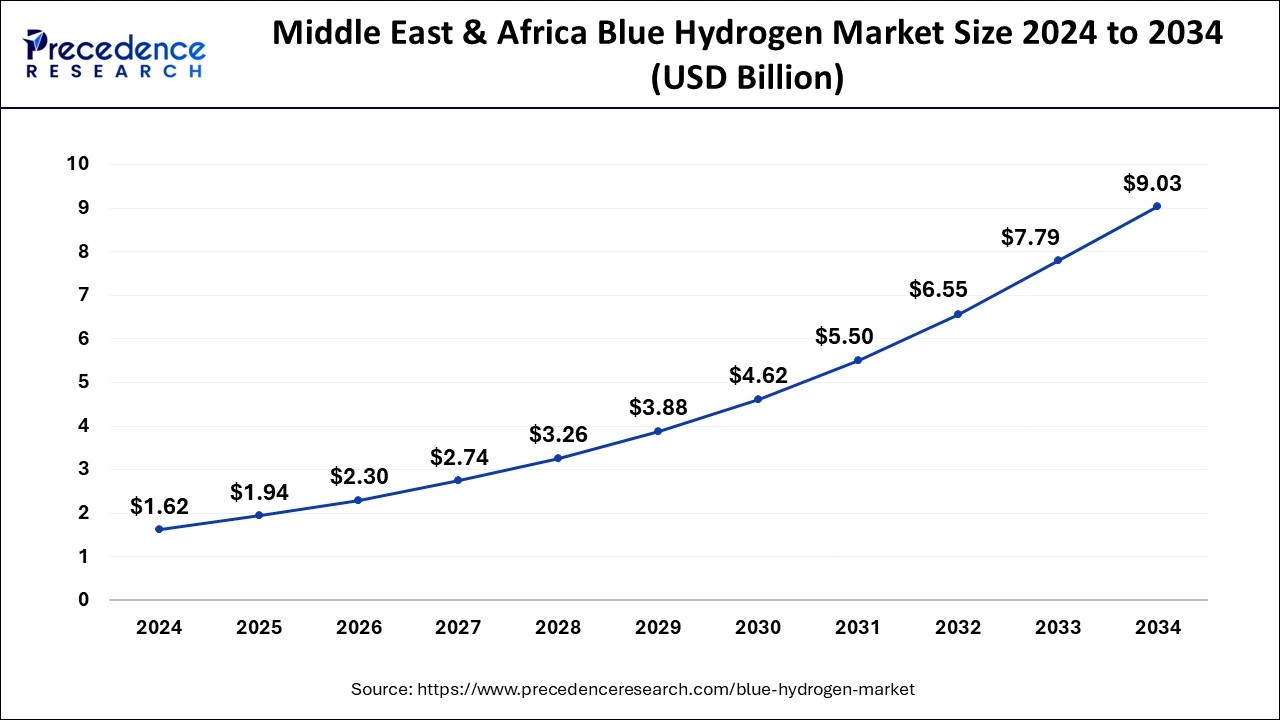
Middle East & Africa dominated the blue hydrogen market in 2024. African countries like Egypt, Mauritania, Morocco, and South Africa will be key contributors to the emerging hydrogen market in the MEA. These countries are leveraging theirrenewable energy resources to produce green hydrogen for both domestic use and to meet the increasing demand in markets such as Europe. Several large-scale low-carbon hydrogen projects are in the pipeline for the region, enhancing its position in the global hydrogen market.
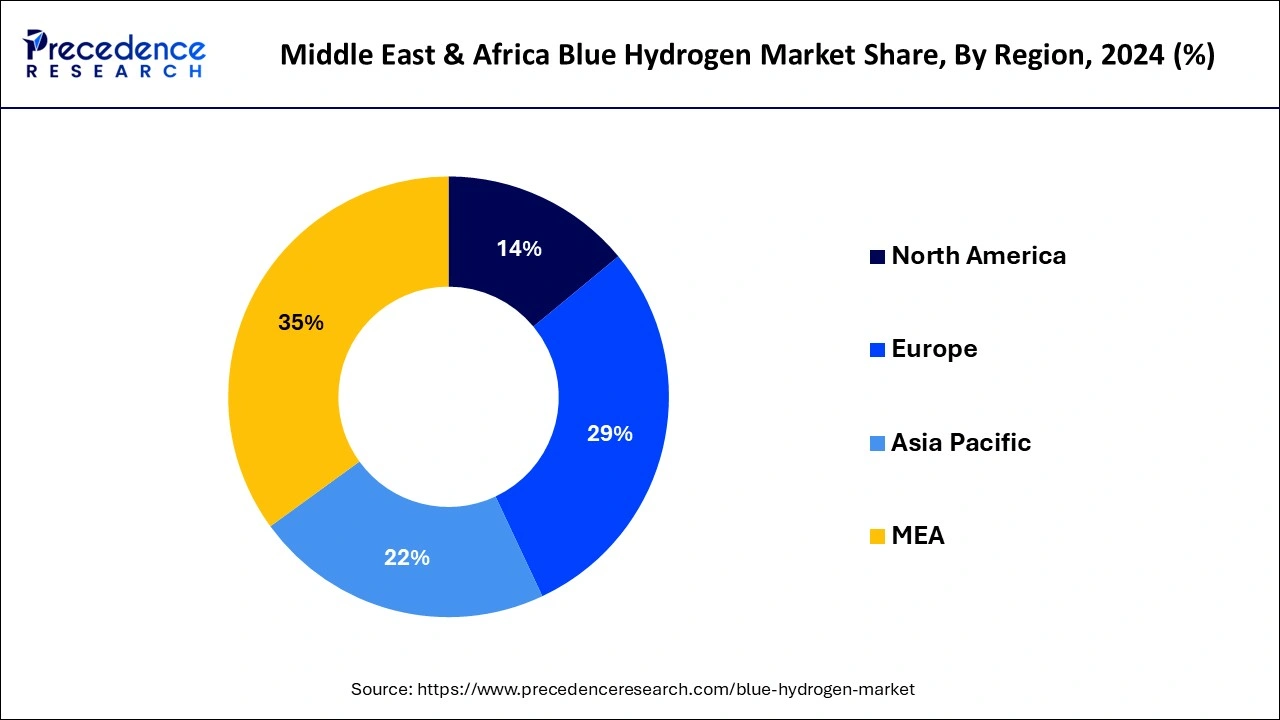
Europe is projected to hold the fastest-growing blue hydrogen market during the forecast period. The European blue hydrogen market is anticipated to grow due to the rising demand for fuel cell-based electric vehicles and a transition toward a hydrogen-based economy. This growth is further supported by favorable government initiatives and the increased adoption of blue hydrogen across the region.
- In December 2023, Green hydrogen technology company AFC Energy started up an ammonia cracker in the UK capable of supplying 400kg of hydrogen daily. The world's largest demonstration project to date. The facility currently converts imported grey ammonia supplied by chemicals firm OCI's Port of Rotterdam terminal, originally produced in the U.S., Middle East, and North Africa, where gas prices are much lower than in Europe, to H2.
Market Overview
Blue hydrogen, produced from natural gas and supported by carbon capture and storage, is a low-carbon alternative that eliminates CO2 emissions. The entities involved in the development, production, and commercialization of this compound, along with the end users, from the blue hydrogen market. Various technologies are currently used to produce hydrogen, such as steam methane reforming, partial oxidation of oil, coal gasification, and auto-thermal reforming.
Today, most hydrogen is derived from fossil fuel reforming, primarily used in petroleum refineries and fertilizer manufacturing. However, this method emits CO2, giving limited climate benefits. Hydrogen has diverse applications, from industrial feedstock to fuel cell vehicles and energy storage. The rapid development and innovation in green hydrogen technology could hinder market growth despite its numerous applications.
Blue Hydrogen Market Growth Factors
- Government initiatives to develop a hydrogen economy can fuel market growth shortly.
- New projects considering blue hydrogen generation globally are expected to boost the market growth.
- Rising industrialization and globalization are some of the key factors driving the growth of the blue hydrogen market during the forecast period.
- The growing usage of hydrogen in fuel cells can contribute to the expansion of the blue hydrogen market further.
- Technological advancement in generating blue hydrogen can also propel market growth.
Market Scope
| Report Coverage | Details |
| Market Size in 2025 | USD 5.53 Billion |
| Market Size by 2034 | USD 25.45 Billion |
| Growth Rate from 2025 to 2034 | CAGR of 18.55% |
| Largest Market | Middle East & Africa |
| Base Year | 2024 |
| Forecast Period | 2025 to 2034 |
| Segments Covered | Technology, Transportation Mode, Application and Regions |
| Regions Covered | North America, Europe, Asia-Pacific, Latin America, and Middle East & Africa |
Market Dynamics
Driver
Government initiatives and regulations
Government initiatives and regulations play a crucial role in driving the global blue hydrogen market. Many governments worldwide are implementing policies and regulations to promote the use of low-carbon fuels like hydrogen, addressing the challenges posed by climate change and air pollution. Measures such as carbon pricing and taxes are being introduced to incentivize the transition to low-carbon fuels. This has led to increased demand for blue hydrogen, which emits less carbon than traditional fossil fuels.
Policies that promote renewable energy sources such as wind and solar power are contributing to the growth of renewable energy. Additionally, blue hydrogen can be produced using renewable energy, further reducing its carbon footprint. Governments are offering various incentives to encourage the adoption of clean energy, including grants and tax credits for companies investing in hydrogen production or using hydrogen in their operations. These initiatives are essential in accelerating the shift towards cleaner energy solutions and reducing greenhouse gas emissions.
- In February 2023, Linde secured a long-term contract to supply clean hydrogen and other industrial gases to OCI's planned world-scale blue ammonia factory in Beaumont, Texas.
Restraint
Presence of methane
The presence of methane, a potent greenhouse gas in natural gas, is a significant barrier to the profit growth of the blue hydrogen market. Methane leaks during blue hydrogen production contribute to global warming. Moreover, using natural gas to generate the substantial energy needed for manufacturing blue hydrogen results in carbon dioxide emissions, which limits revenue growth in the market. Additionally, the lack of infrastructure poses a particular challenge in developing countries. These regions often have limited access to the necessary technology, expertise, and funding required for the widespread adoption of blue hydrogen technologies.
Opportunity
Rising demand for cleaner energy
The growing demand for cleaner energy sources and clean hydrogen across various industries, including petroleum refining, power generation, chemical, and transportation, is a key driver of market growth. This demand is bolstered by the increasing adoption of hydrogen-powered fuel cells, which are lightweight, pollution-free, space-efficient, and offer higher energy storage density and longer range compared to traditional combustion technologies like lithium-ion batteries.
Fuel cell electric vehicles (FCEVs) are gaining popularity due to their low refueling and maintenance costs, as well as zero emissions, which is accelerating their adoption rates. Governments are further supporting this trend with favorable initiatives to promote fuel-cell vehicles, such as tax rebates and subsidies. These measures aim to reduce carbon emissions and decrease dependence on fossil fuels, which can contribute to the blue hydrogen market growth.
- In January 2024, Thyssenkrupp Steel launches a tender for up to 151,000 tonnes of annual clean hydrogen supply in Germany. Steelmaker is seeking ten-year contracts for green or blue H2 to reduce emissions at the country's largest steel mill.
Technology Insights
The steam methane reforming segment was the dominant technology in the blue hydrogen market in 2024. Steam methane reforming (SMR) is a method used to extract hydrogen from natural gas (methane), which is one of the most economical sources of industrial hydrogen. This process involves heating methane with steam and a catalyst, causing an endothermic reaction. This reaction breaks down the methane molecule into carbon monoxide and hydrogen. SMR is known for its cost-effectiveness and energy efficiency in producing high-purity hydrogen, which can then be collected using in-house pressure swing adsorption purification technology. The expected increase in the adoption of SMR is anticipated to drive market growth during the forecast period.
The auto thermal reforming segment is expected to grow at a significant rate in the blue hydrogen market over the forecast period. Autothermal reforming (ATR) is another technology used to produce blue hydrogen. It involves a combination of steam and oxygen to convert natural gas into hydrogen and carbon dioxide. ATR can achieve a higher purity of hydrogen compared to steam methane reforming (SMR), but it is more complex and costly.
- In September 2023, Technip Energies, in partnership with Casale, will add advanced auto thermal reforming technology to Blue H2 by T. EN™, its unique suite of fully integrated, low-carbon hydrogen solutions. It is part of Capture. Now™, its strategic platform for CCUS, which delivers technology and solutions from a single provider tailored to meet clients' specific decarbonization and performance needs.
Transportation Mode Insights
The pipeline segment dominated the blue hydrogen market in 2024. The growth of this segment of the blue hydrogen market is driven by the transportation of large volumes in gaseous form through pipelines, which provide cost-effective and long-distance coverage. These pipelines are typically situated in regions with high concentrations of large consumers of blue hydrogen, such as chemical manufacturing units, refineries, and power generation plants.
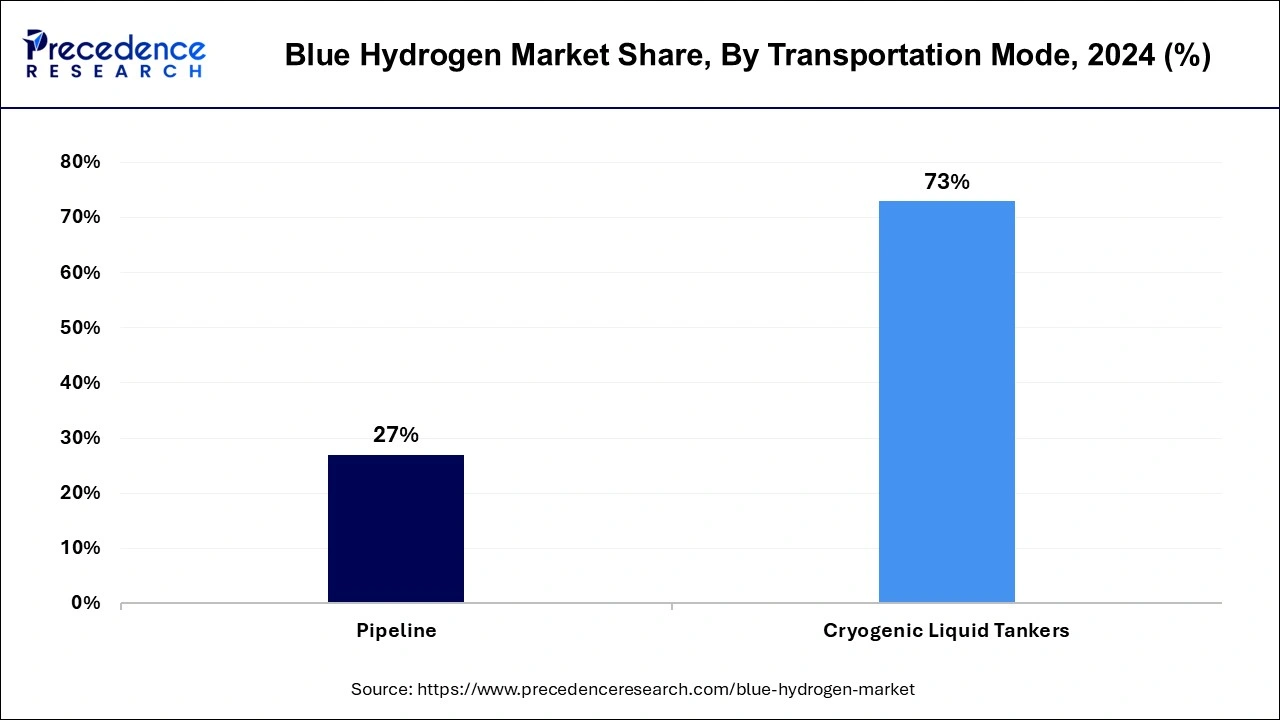
The cryogenic liquid tankers segment is expected to grow at the fastest rate during the forecast period. Cryogenic tanks are specifically designed for the storage and transportation of liquefied gases like liquefied natural gas (LNG), liquid oxygen, liquid nitrogen, and liquid argon. These tanks, which number over 250,000 units, can store gases at very low temperatures, below -150 degrees, and at high pressures.
- In February 2022, Boeing's large, fully composite, lineless cryogenic fuel tank passed a critical series of tests at NASA's Marshall Space Flight Center and, by doing so, has proved itself as a mature, safe, and ready-to-use technology for aerospace vehicles.
Application Insights
The power generation segment dominated the blue hydrogen market in 2024. Around 96% of the world's hydrogen is produced from fossil fuels like coal, oil, and natural gas using a technique called reforming, which involves heating these fuels with steam to approximately 800°C. Hydrogen fuel cells generate energy by combining hydrogen and oxygen atoms in an electrochemical reaction similar to that of a battery, resulting in electricity, water, and a small amount of heat. Unlike fossil fuels, hydrogen fuel cells do not produce greenhouse gases during their operation, which is expected to drive the demand for blue hydrogen in power generation and contribute to market revenue growth.
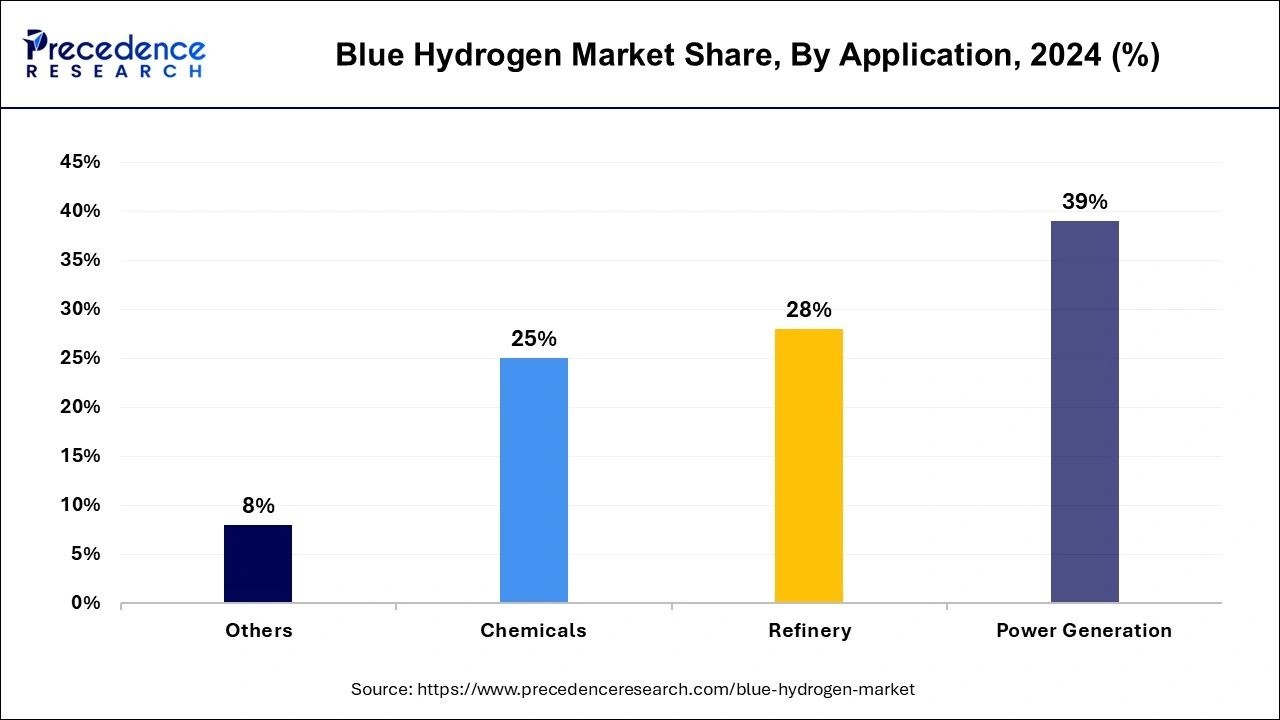
The refinery segment is anticipated to grow at the fastest rate in the blue hydrogen market over the projected period. This method produces carbon dioxide as a byproduct. To achieve their sustainability goals, these companies are adopting sustainable production processes by installing carbon capture storage systems to store the carbon dioxide produced during hydrogen generation. Several petrochemical companies, such as Exxon Mobil Corp., generate hydrogen for their oil and petroleum refineries using steam methane reforming technology. This transformation helps convert their grey hydrogen into sustainable blue hydrogen with zero carbon emissions and drives the demand for blue hydrogen generation in the refinery industry.
Blue Hydrogen Market Companies
- Linde Plc
- Shell Group of Companies
- Air Liquide
- Air Products and Chemicals, Inc.
- Engie
- Equinor ASA
- SOL Group
- Iwatani Corp.
- INOX Air Products Ltd.
- Exxon Mobil Corp.
Recent Developments
- In February 2023, Linde announced plans to develop a USD 1.8 billion blue hydrogen facility on the Texas Gulf Coast to feed ammonia production. The business intends to start production around 2025.
- In March 2022, Air Products Inc. announced its plans to construct and operate a new liquid hydrogen production plant in Casa Grande, Arizona. The facility will be designed to produce up to 30 tons per day of liquid hydrogen using Air Products' proprietary natural gas liquefaction technology. The company has stated that the facility will be a zero-carbon plant powered entirely by renewable energy sources such as wind and solar power.
- In January 2022, Linde plc. and Yara signed an agreement to construct and deliver a 24 MW hydrogen plant. This is a significant development in the blue hydrogen market, as it demonstrates the growing interest and investment in this technology. The new hydrogen plant is expected to be operational in 2024 and will produce low-carbon hydrogen using natural gas with carbon capture and storage technology.
Segments Covered in the Report
By Technology
- Steam Methane Reforming
- Gas Partial Oxidation
- Auto Thermal Reforming
By Transportation Mode
- Pipeline
- Cryogenic Liquid Tankers
By Application
- Chemicals
- Refinery
- Power Generation
- Others
By Geography
- North America
- Asia Pacific
- Europe
- Latin America
- Middle East & Africa
For inquiries regarding discounts, bulk purchases, or customization requests, please contact us at sales@precedenceresearch.com
Frequently Asked Questions
Ask For Sample
No cookie-cutter, only authentic analysis – take the 1st step to become a Precedence Research client
 sales@precedenceresearch.com
sales@precedenceresearch.com
 +1 804-441-9344
+1 804-441-9344